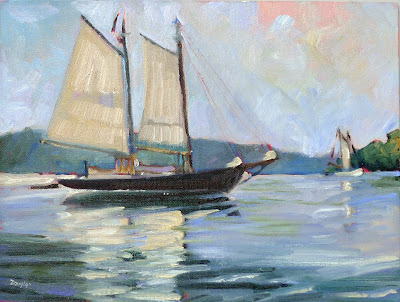Our national identity is to be found in diners and city parks, cypress swamps and little towns, local church services, at Home Depot, on city streets and lonely country roads.
 |
| I may have the wrong footwear for Buffalo… |
As much as I like overseas travel, I’ve never felt the urge to teach in another country. Landscape painting conveys a deeper shade of intimacy that I simply don’t feel when visiting other places. I enjoy them, but I don’t love them in the same way as I love the US and Canada.
I took this trip to pave the way for a workshop in the Deep South. Why didn’t I just head to the more familiar eastern seaboard states? I’m familiar enough with them that a road trip wasn’t necessary. The central south has been calling to me for a long time, although I’m still not sure what it’s saying.
I usually approach Kentucky from the north. It seems very southern compared to Ohio. This time, driving up from Mississippi, it seemed northern, its drawl flattened out to a midwestern twang. Either way, its identity is confused. This is where the great antislavery novel,
Uncle Tom’s Cabin, was set. When Eliza struggled across the frozen Ohio River, she was literally leaping from slavery to freedom.
 |
| One-lane road, central Kentucky. |
And yet, nowhere was ‘brother against brother’ truer than in Kentucky. The state tried to sit out the Civil war, but its self-declared neutrality was ignored by both sides. Eventually, it cast its lot with the Union. But southern sympathies were strong, and a group of citizens formed a shadow government that joined the Confederacy.
I came to love Kentucky when I did art festival in Louisville. Now I take every opportunity to shun-pike through this state. It has beautiful farms, lovely steep hollows and hills, and
the biggest known cave system in the world. But I was being a serious driver yesterday, intending to get from Bowling Green to Buffalo, NY in one shot. That meant sticking to the Interstate system like a burr on a saddle-blanket.
 |
| Dogwood and distillery. |
Maybe it was the knowledge that there was snow ahead, but I couldn’t resist veering down the Bluegrass Parkway. This runs east to Kentucky horse country. These are the most manicured farms in America, and the horses—even the ones free to graze near the road—are beasts of singular beauty. The spring grass is in, and the horses were gamboling in the sun.
Before I got that far, I saw a sign for
Kentucky’s Bourbon Trail. That eventually put me on a series of one-lane roads. The blind corners, cropped hedges and small-town distilleries reminded me of the Isle of Skye.
Most of us, when we say we’ve ‘been to’ a place, mean we’ve driven through on the Interstate or we’ve flown in, gone downtown, eaten at trendy restaurants and seen a few tourist sites. You really don’t learn much about your country like that. Our common ground is to be found on the old Federal routes, at diners and city parks, in cypress swamps and little towns, at local church services, or talking to the guy at Home Depot. We should all do more of that.



















